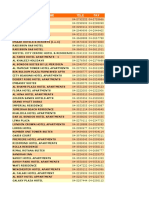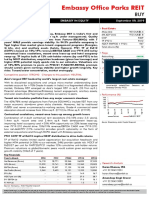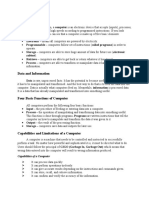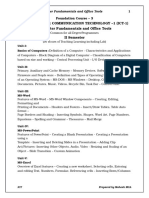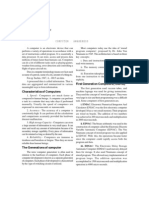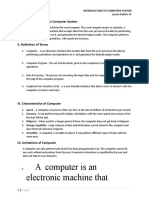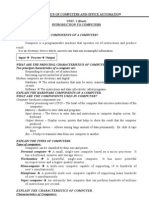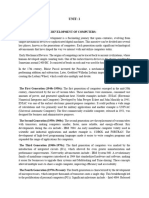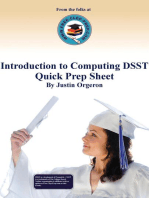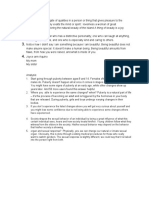Lite - Prelim
Lite - Prelim
Uploaded by
jennygumafelixCopyright:
Available Formats
Lite - Prelim
Lite - Prelim
Uploaded by
jennygumafelixOriginal Title
Copyright
Available Formats
Share this document
Did you find this document useful?
Is this content inappropriate?
Copyright:
Available Formats
Lite - Prelim
Lite - Prelim
Uploaded by
jennygumafelixCopyright:
Available Formats
LITE - PRELIMS Software - a generic term used to refer to applications,
scripts and programs that run on a device.
Computer In our Daily Life
ADVANTAGES OF INFORMATION TECHNOLOGY
Technology – advancement in communication and how
information is handled. Protecting and Storing Information
Virtual vaults keep information safe by limiting
Computer – refers to an electronic device that accepts
access.
data and instructions.
Automated Processes
Performs logical and mathematical operations. Communication
Generates the outputs of the process. Remote Access or Telecommuting
CHARACTERISTICS AND CAPABILITIES OF COMPUTER DISADVANTAGE OF INFORMATION TECHNOLOGY
Speed - The computer can work very fast. It takes only a Expenses of Implementation and Maintenance
few seconds for calculations that we take hours to Elimination of Jobs
complete.
WHAT IS INFORMATION AND COMMUNICATION
Accuracy - The degree of accuracy of a computer is very TEACHNOLOGY?
high and every calculation is performed with the same
ICT - is the technology required for information
accuracy.
processing, in particular, the use of electronic
Diligence - A computer is free from tiredness, lack of computers, communication devices, and software
concentration, fatigue, etc. It can work for hours applications to convert, store, protect, process, transmit
without creating any errors. and retrieve information from anywhere, anytime.
Versatility - It means the capacity to perform Technology that supports activities
completely different types of work. You may use your involving information such as gathering,
computer to prepare payroll slips. processing, storing, and presenting data.
Power of Remembering - A computer has the power of Information - refers to the knowledge obtained from
storing any amount of information or data. reading, investigation, study, or research.
No IQ (Intelligence Quotient) - A computer is a dumb Communication - is an act of transmitting messages. It is
machine, and it cannot do any work without instruction a process whereby information is exchanged between
from the user. individuals using symbols, signs, or verbal interactions.
No Feelings - It does not have feelings or emotions, Technology - is the use of scientific knowledge,
taste, knowledge, or experience. experience, and resources to create processes and
products that fulfil human needs.
Storage - The Computer has an in-built memory where
it can store a large amount of data. USES OF ICT IN OUR DAILY LIVES
WHAT IS IT? Communication
Job Opportunities
Information Technology (IT) – pertains to the industry
Education
that involves computers, software, networking, and
Socializing
other IT infrastructure to help relay or manage
information important in modern days. POSITIVE IMPACT OF ICT
Hardware – computers physical devices. Access to information
Any part of the computer that can be seen and New tools, new opportunities
touched. Communication
Information Management
Security
Distance Learning commercially successful calculating machine. The
Creating of new more interesting jobs machine could perform the four basic mathematical
functions. The first mass produced calculating machine.
NEGATIVE IMPACT OF ICT
Electronic Devices
Job Loss
Reduce personal Interaction. ABC (Atanasoff-Berry-Computer) - The first special-
Reduce physical activity. purpose digital computer that solves simultaneous
Cost equations. It was developed by John Atanasoff.
Competition Electronic Numerical Integrator and Calculator (ENIAC) -
WEEK 3 – HISTORY OF COMPUTER The first fully electronic general-purpose digital
computer ever completed by John Mauchly and J.
Evolution of Computer Presper Eckert.
A – Pre-Modern Era - There are three classifications of Electronic Delay Storage Automatic Calculator (EDSAC).
devices that evolved during the premodern era namely It is also known as an Electronic Binary Digital computer
manual-mechanical devices, electromechanical, and that uses a binary representation of data and internally
electronic devices. stored programs; the first full-size stored-program
Manual-Mechanical Devices are devices that are computer, built at the University of Cambridge, England
operated manually by the user. by Maurice Wilkes, and others to provide a formal
Tally sticks - A tally stick was an ancient memory aid computing service for users. EDSAC was built according
device to record and document numbers, quantities, or to the von Neumann machine principles.
even messages. B. First Generation Computers (1946-1959)
Abacus - It is also called a counting frame and is - The size of computers while the first-generation
considered the first manmade computing device. In computers are mainframes. The major hardware
fact, it was used for centuries. features are vacuum tubes and magnetic drums, and
Napier’s Bones - It is a manually operated device used the processing speed is 1,000 instructions per second.
for calculating products, quotients, square and cube Universal Automatic Computer (UNIVAC). It is the first
roots. It was invented by John Napier in 1614. commercial business computer and was developed by
Oughtred’s Slide Rule - It is a mechanical analog John Eckert and John Mauchly. Another example is the
computer consisting of movable bars with a precise IBM 701 which is the first-generation IBM computer.
scale that uses approximations for solving problems like The most popular 1st generation computer is IBM 650.
multiplication, division, roots, logarithms, and C. Second Generation Computer (1959 – 1965)
trigonometry. It was invented by William Oughtred.
- The major hardware features of second-generation
Pascaline Calculator - It is also called Adding Machine. It computers are transistors and magnetic cores. Its
is the first mechanical calculating device that uses processing speed is 1,000,000 instructions per second
cogged wheels that can be used to add and subtract and the size is mainframe.
two numbers. It was invented by Blaise Pascal in 1642.
TRADIC is one example of a second-generation
Stepped Reckoner - Invented by Gottfried Wilhelm computer. It is the first transistorized computer. More
Leibniz in 1672. The machine can add, subtract, examples of second-generation computers are UNIVAC
multiply, and divide automatically. II, IBM 7070, 7090, and 1400 series.
Babbage’s Difference and Analytical Engines - These D. Third Generation Computers (1965 – 1971)
engines embodied most of the design of modern
computers. - During the third generation, minicomputers already
became available. The major hardware features are
Arithmometer - A mechanical calculator invented by integrated circuits or “chips”, and the processing speed
Thomas de Colmar in 1820, The first reliable, useful, and is 10,000,000 instructions per second.
- In 1965, Jack Kilby invented the integrated circuit (IC) calculated in floating point operations per second
that was used instead of transistors as the interior (FLOPS).
section to build the computer.
Mainframe computers - are large-sized computer types.
IBM System 360- It is the first general-purpose machine They are equally powerful but fall short in terms of the
used in science and business. computation ability in supercomputers. Also called big
iron.
E. Fourth Generation Computer (1971- 1980)
Minicomputers - are general-purpose devices without
- The size of a computer varies from mainframes,
the monumental expenses associated with a larger
minicomputers, and microcomputers. The major
system.
hardware features are microprocessors or large-scale
integrated circuits. The minimum processing speed is Microcomputers are the smallest, least expensive, and
100,000,000 instructions per second. most used types of computers. They have small
memories, less processing power, are physically smaller,
F. Fifth Generation Computers (1980-onwards
and permit fewer peripherals compared to super and
- Based on Artificial Intelligence (AI). mainframe computers. They are more commonly
known as personal computers or simply PCs. The term
- Ultra large-scale integration (ULSI) was initially used to refer to IBM-compatible computers.
CLASSIFICATION OF COMPUTER WEEK 4 – COMPONENTS OF COMPUTER
According to Purpose Hardware – refers to the physical and tangible
General-purpose computers have the ability to store components of the computer system.
different programs of instruction and thus perform a Components of the Internal Hardware
variety of operations. Examples of general-purpose
computers are personal computers, laptops, and Central processing unit (CPU)- executes all the
tablets. instructions, and it is considered the brain of the
computer system. The parts of the CPU are control unit
Digital Computers refer to machines that specialize in (CU) and Arithmetic/logic unit (ALU)
counting. It operates by counting values that are
discrete, or separate and distinct. Memory – it stores data and instructions before
execution and the processed data as well.
Analog Computers. The name analog comes from the
word “analogous” meaning similar. Analog computers Types of Memory
are used for scientific, engineering, and process control
Internal Memory
purposes. They deal with quantities that are
Random – Access Memory (RAM) – It is a
continuously variable. One example is the analog
volatile type of memory.
speedometer in an automobile.
Refers to as main memory or primary
This special-purpose machine called a hybrid computer memory.
combines the measuring capabilities of the analog Read-Only Memory (ROM) – contains
computer and the logical and control capabilities of the permanently stored instructions that cannot be
digital computer. It offers an efficient and economical changed.
method of working out special types of problems in External Memory
science and various areas of engineering. Secondary Memory – also known as Auxiliary
Memory.
According to Capacity
It is a non-volatile memory that is
Supercomputers - These are arguably the most responsible for keeping files permanently.
powerful in terms of speed and accuracy. They are
Input and Output Unit – it allows communication
types of computers used in solving complex
between the computer and its outside world via input
mathematical computations. They are capable of
and output devices.
executing trillions of instructions per second, which is
Other parts that go along with the processor: Scanning Device - It translates images of text, drawing,
and photos and the like into forms of data that can be
Bus – an electronic circuit that sends data and messages
understood by the computer.
between the other components.
Bar code readers - photoelectric scanner that translate
Ports – it attaches input and output devices to the
the bar code symbols into digital forms.
computer.
Mark and Character recognition devices
Expansion slots – it allows the addition of extra features
MICR (Magnetic-Ink Character Recognition) – it
Registers – are special temporary storage which quickly
reads the strange-looking numbers printed at
accepts, stores, and transfers data and instructions for
the bottom of bank checks.
immediate use.
OMR (Optical Mark Recognition) – reads pencil
Components of the External Hardware marks.
OCR (Optical Character Recognition – it reads
Input Hardware – it accepts or collects data and
special preprinted characters.
converts it into a form suitable for processing.
Fax Machine (Facsimile Transmission Machine) - – it
Types:
scans an image and sends it as an electronic signal over
Keyboard – Entry Devices telephone lines.
Keyboards – commonly used input device.
Imaging Systems/Image Scanner/Graphic Scanner - – it
Terminals – it consists of keyboards, a video
converts text, drawings, and photographs into forms.
display screen, and a communication line to
a mainframe computer. Smart Cards and Optical Cards
THREE TYPES OF TERMINALS Smart cards- it contains a microprocessor and a
memory chip.
Dumb – can be used only to input data to and Optical Cords – it is a plastic, Laser-recordable
receive information from a computer system. card used with an optical card reader.
Smart – can do input and output and has some
limited processing capability. Other Devices:
Intelligent – a full fledge microcomputer with a
Voice Recognition System - they convert human speech
communication link.
into digital code.
Direct-Entry Devices
Audio- Input Device – They record or play analog sounds
Pointing Devices
Video- Input Device – signals that come from VCR or a
Mouse – a pointing device that allows you to
camera recorder.
control an on-screen cursor.
Trackball – the upside-down version of the Electronic Cameras – they capture images in electronic
mouse. A ball mounted in box is rolled with the form.
fingers to move the cursor.
Sensors – it collects specific kinds of data directly from
Joystick – a video display screen that picks up
the environment.
input from the user through the touch of a
finger. Processing Hardware - - It is used to retrieve and
Light Pen – it is a point and draw input devices execute the instructions provided by the computer.
that allows you to draw directly on screen.
Main Component; CPU and Main Memory
Digitizing tablet – a pen-like device with which
the user ‘sketches’ an image or puck System Unit –it contains electrical components that
Pen based systems – a pen like stylus to enter make the computer.
handwriting and marks into a computer.
Power supply – is a device that converts AC to
DC power to run the computer.
Motherboard – it is the main circuit board in the Drum – a recording medium of data represented by
system unit. magnetized spots that is coated with a magnetically
CPU – the microprocessor chip. sensitive material divided into tracks.
Specialized Processor chips – used to speed up
Continuous forms – long sheets of paper where data is
your computer system.
represented through print out.
System clock – it controls how fast all
operations within a computer are performed. Computer Output Microfilm (COM)- stores large volume
Cache memory – is the special high-speed of information printed or photographed as a very small
memory that the CPU can access quickly. images on sheets or roll of film called Microfiche.
Expansion slots and boards- are sockets on the
Output Hardware - It provides a means for the user to
motherboard into which you can plug
view information produced by the computer system.
expansion cards or boards.
Bus line – the electrical pathways through Two Forms:
which nits are transmitted within the CPU and
Hardcopy – it is when information has been recorded in
between the CPU and other devices in the
a tangible medium, such as paper or microfilm.
system unit.
Port – the sockets on the outside of the system Printer – it is capable of printing characters,
unit that each connected to an expansion board symbols, and graphics.
on the inside of the system unit. Impact printer – it has contact with papers like
PCMICIA slots and cards – it represents a new daisy wheel printers, dot-matrix printers, and
bus standard for notebooks, subnotebooks, and line printers.
pocket computers. Non-impact printers –it has no contact with the
paper like laser printers, ink-jet printers, and
Storage Hardware - It temporarily or permanently
thermal printers.
stores data used for processing and the output of such
processing. • Plotter – they are specialized output devices that
can produce high quality graphics in a variety of
Two Types:
colors.
Primary Storage – refers to main memory (RAM)
Three types of Plotters
Secondary Storage - refers to storage devices that retain
data and instruction in a relatively permanent (non- Pen plotter – the most popular type of
volatile) form. plotter
Electrostatic plotter – electrostatic charges
Optical storage – use a laser beam to pack information create tiny dots on specially treated paper.
densely on our movable disk. Thermal plotter – its pins are electronically
heated and are used with heat-sensitive
Magnetic tapes – sequential file storage represented by
paper to produce images.
various arrangements of magnetized spots along the
width of the tape. Softcopy – it is when an output is temporarily displayed
on the screen.
Magnetic disk – a metal plotter where data is
represented by magnetized spots on the tracks. Cathode Ray Tube (CRT) – the most popular
softcopy output device used on
Magnetic strip – a recording of a data cell device
microcomputers.
capable of storing 400 million of data.
Flat Panel Displays – they are used with
Paper tape – a continuous strip of paper wound on a portable computers.
reel where data is represented by holes punched on the
paper. Communication Hardware - It facilitate the connection
between computers connected with a network of
computers over phone lines and other channels.
Modems - it converts digital signals to analog signals. WEEK 5 – INFROMATION AGE
Cable – commonly used in networking, to facilitate WHAT IS THE INFORMATION AGE?
communication between those computers.
- is the idea that access to and the control of
Fax modems – a modem with fax capability installed as information is the defining characteristic of this current
a circuit board in the motherboard of a computer. era in human civilization.
Multiplexers – it combines several low-speed - also called the Computer Age.
transmissions into one high-speed transmission.
- historians trace its beginnings to the work of the
Concentrator- it collects data in a temporary storage American mathematician Claude E. Shannon, known as
area, then sends it forward when enough has been the "father of Information Theory."
accumulated.
ORIGIN OF THE INFORMATION AGE
Front-end Processor- a computer that handles
In 1948, at age 32 and as a researcher at Nokia Bell
communications for mainframes.
Laboratories, Shannon published a landmark paper
Software - refer to applications, scripts and programs proposing that information can be quantitatively
that run on a device. encoded as a series of ones and zeroes.
Categories of Software
1. System software – facilitating applications programs
a. operating system - refers to a group of related
programs that supervise the execution of an
application program.
b. operating environment - refers to programs
that sit on top of OS. WHAT IS DIGITAL AGE
c. utilities - a single term for all types of
-refers to a historical era and information technology-
programming aids.
based economy originating in the twentieth century. It
d. programming damages - the programs used to
is marked by a rapid transition from the industrialized
write other programs.
economy brought about by the Industrial Revolution to
e. language processor - used to convert source
a knowledge-based economy.
program into a form suitable for execution.
Compliers, Assemblers, Interpreters with the Internet Age, which describes the time since
the public first had access to the Internet, as well as the
2. Application Software – use program design to solve
fundamental changes it brought about in terms of
problems.
information availability and worldwide communication.
Types of application software
DIGITAL AGE TIMELINE
- Package Program – commonly called application
- 1940s: this was the beginning of the discipline
package.
of information science.
- Custom Program – specifically written for an
- Late 1940s: universities, the military, and
organization.
companies created computer systems to
Levels of Programming Languages digitally copy and automate previously done
mathematical operations by hand.
1. Machine language - 1970s: the Altair Microcomputer Kit, the first
2. Symbolic language home computer, was released.
3. High level language - 1980s: computers entered semi-ubiquity
Peopleware - refers to the personnel involved in data (almost everywhere) as people brought them
processing operations. into homes, businesses, and industries.
- Late 1980s - 1990s: Tim Berners-Lee invented - Multi Identity
the World Wide Web, which became publicly - Cyber Crime
accessible. - Privacy issue
- 2000s: cell phones outpaced phones of the 90s - Hate Speech
in terms of technological advancement and - Collapse of Traditional Economic Models
became as commonplace as computers. Text
messaging exploded in popularity.
- 2010s to the present: both smartphone use, NEW MEDIA: NEW HORIZONS
and console ownership increased in popularity.
- Virtual socialization
FEATURES OF DIGITAL AGE - Cyber Entrepreneurship
- New Business Models
1. New Technological Networks
- Global Political Organizations and Movements
2. Mobility Due to New Technology
NEW MEDIA: NEW FORMS & CONTENT
3. Consumerization Due to New Technology
4. Misinformation and Disinformation Due to New
Technology
5. New Technology and Globalization
6. Security Concerns Due to New Technology
WHAT IS THE NEW MEDIA AGE?
NEW MEDIA: NEW JOBS
- refers to the development of interactive
technologies that began during the late 20th
century and has continued into the 21st
century.
- first became widely available in homes during
the mid to late 1990s, including blogs, Internet
video and other social networking tools.
- encompasses cellular technologies and
applications that are compatible with the
Internet and its various platforms of NEW MEDIA: FUTURE
interactivity.
EVOLUTION OF MEDIA
NEW MEDIA: NEW PROBLEMS
You might also like
- Vocab Files Book b2 Unit 1Document7 pagesVocab Files Book b2 Unit 1chrystin2009100% (3)
- Mathematics G9: Quarter 2Document40 pagesMathematics G9: Quarter 2Kyung Soo88% (8)
- Hotels NewDocument69 pagesHotels NewBrave Ali Khatri0% (1)
- Biography Lesson PlanDocument3 pagesBiography Lesson Planapi-357243074No ratings yet
- Ambit Embassy Office Parks REIT Initiation The PDFDocument45 pagesAmbit Embassy Office Parks REIT Initiation The PDFanil1820No ratings yet
- Catalyst 6000 Family Software Configuration GuideDocument880 pagesCatalyst 6000 Family Software Configuration GuideMaximo ExilioNo ratings yet
- ICT FundamentalsDocument17 pagesICT FundamentalsselvaNo ratings yet
- 120 HRS THEORY BOOKDocument19 pages120 HRS THEORY BOOKblingsingh471No ratings yet
- Topic 1_Introduction to ICTDocument43 pagesTopic 1_Introduction to ICTjbf2023-7887-76102No ratings yet
- LENS-Basic Computer ConceptsDocument11 pagesLENS-Basic Computer ConceptsDani Jiel MercadoNo ratings yet
- Chapter 1 Computers and IT2Document32 pagesChapter 1 Computers and IT2Ana Luisa BuenNo ratings yet
- Information & Communication Technology - 1 (Ict-1) Computer Fundamentals and Office Tools II SemesterDocument60 pagesInformation & Communication Technology - 1 (Ict-1) Computer Fundamentals and Office Tools II Semestermuralidhar.kurniNo ratings yet
- IT BeginerDocument10 pagesIT Beginershantanu dasNo ratings yet
- Introduction To Ict - 2023Document30 pagesIntroduction To Ict - 2023usmantukurNo ratings yet
- MTH 208-Intro To Comp ProgrammingDocument64 pagesMTH 208-Intro To Comp ProgrammingMuhammad Ibrahim SugunNo ratings yet
- Information Technology: Part-ADocument42 pagesInformation Technology: Part-Akshitij94No ratings yet
- AcSIR ComputerApplcnsDocument99 pagesAcSIR ComputerApplcnsShabeer Ali PCNo ratings yet
- Connect Hardwre PeripherialsDocument35 pagesConnect Hardwre PeripherialsGizaw TadesseNo ratings yet
- Computer Principles Lecture 2Document6 pagesComputer Principles Lecture 2mohsindalvi87No ratings yet
- IT ReviewerDocument4 pagesIT ReviewerCheena Mae LagunillaNo ratings yet
- Introduction To ComputerDocument28 pagesIntroduction To ComputerSAGAR RAHEJANo ratings yet
- W-1 Introduction-1Document26 pagesW-1 Introduction-1Umair AhmadNo ratings yet
- Unit I - IntroductionDocument48 pagesUnit I - IntroductionThamarai Selvi KoselramNo ratings yet
- Module 1Document18 pagesModule 1ajayvempuluru123No ratings yet
- LECTURE 1 - Fundamentals of ComputerDocument11 pagesLECTURE 1 - Fundamentals of ComputerJa-son Ismay NeymNo ratings yet
- It Era PointersDocument4 pagesIt Era PointersMARYJUN EJOSNo ratings yet
- Introduction To Computer Hardware: Chapter One Definition of ComputerDocument39 pagesIntroduction To Computer Hardware: Chapter One Definition of Computerweb alamNo ratings yet
- WWW - Sbiexam.in COM 1Document26 pagesWWW - Sbiexam.in COM 1Rohan KapoorNo ratings yet
- Computer FundamentsDocument15 pagesComputer FundamentsArbaaz KhanNo ratings yet
- Lesson 1 - History of Computer PDFDocument8 pagesLesson 1 - History of Computer PDFGemver Baula Balbas100% (1)
- Ictd 111 GRP 5Document26 pagesIctd 111 GRP 5El-Bernard NyarkoNo ratings yet
- Intro To IT Lecture 2ADocument28 pagesIntro To IT Lecture 2ARhix JohnNo ratings yet
- CPI 1Document14 pagesCPI 1mohithsg08No ratings yet
- Lesson OutlineDocument9 pagesLesson OutlineBartolome DimautanganNo ratings yet
- FORM 1..PCDocument48 pagesFORM 1..PCsemelionshinsa7No ratings yet
- Introduction To Computer & Word ProcessingDocument54 pagesIntroduction To Computer & Word Processingmaribeth riveraNo ratings yet
- Ge Elect 2 ReviewerDocument6 pagesGe Elect 2 ReviewerReynalyn GalvezNo ratings yet
- Introduction To Computer FundamentalsDocument34 pagesIntroduction To Computer FundamentalsGabriel TadeoNo ratings yet
- I Sem - IT - CompleteDocument130 pagesI Sem - IT - CompletePrameela KNo ratings yet
- Ict and Ethics Notes PDFDocument40 pagesIct and Ethics Notes PDFfelixNo ratings yet
- the computerDocument3 pagesthe computerforza1gamingNo ratings yet
- UNIT 1 - Introduction To ComputersDocument15 pagesUNIT 1 - Introduction To Computersdulceblanco816No ratings yet
- SK Amir Hossain CompOrgDocument11 pagesSK Amir Hossain CompOrgm4kngywpv9No ratings yet
- A Term PaperDocument9 pagesA Term PaperitaobedNo ratings yet
- Chapter 1 Introduction To ComputersDocument9 pagesChapter 1 Introduction To ComputersAustine OumaNo ratings yet
- W 1 IntroductionDocument26 pagesW 1 Introductionaminurrahman333No ratings yet
- Cos 101 - Introduction to ComputingDocument22 pagesCos 101 - Introduction to Computingobotukeme9No ratings yet
- UNIT I.docxDocument11 pagesUNIT I.docxgururajkulkarni40No ratings yet
- Nmec-I Basics of Computers and Office Automation UNIT-I (Start) Introduction To ComputersDocument21 pagesNmec-I Basics of Computers and Office Automation UNIT-I (Start) Introduction To ComputersstaalinNo ratings yet
- Basics of Computer (ICRI)Document43 pagesBasics of Computer (ICRI)Harshada VasaneNo ratings yet
- 2nd Cse CA Study MaterialDocument73 pages2nd Cse CA Study Materialaruntcs2014No ratings yet
- Introduction To Computer HardwareDocument39 pagesIntroduction To Computer HardwareBusiness BusinessNo ratings yet
- Intcom11 Lesson 01Document6 pagesIntcom11 Lesson 01Nicole TalledoNo ratings yet
- Introduction to Information Technology 21 January 2025 (2)Document61 pagesIntroduction to Information Technology 21 January 2025 (2)mc.scelly254No ratings yet
- Pad 116Document34 pagesPad 116Michael T. BelloNo ratings yet
- Learning Objectives: Fundamentals of ComputerDocument6 pagesLearning Objectives: Fundamentals of ComputerJustine JavinezNo ratings yet
- 2. Ite101 Week 3 Topic - History of ComputerDocument63 pages2. Ite101 Week 3 Topic - History of ComputerzpperedaNo ratings yet
- Introduction To Computer SystemDocument7 pagesIntroduction To Computer SystemigbinijesuokosunNo ratings yet
- Resentation ON Omputer EnerationDocument25 pagesResentation ON Omputer EnerationnarayanNo ratings yet
- UNIT 1 FOCDocument9 pagesUNIT 1 FOCved2715anchhuNo ratings yet
- Master of Business Administration (MBA 2) : Mca - Gurmandeep@gmailDocument26 pagesMaster of Business Administration (MBA 2) : Mca - Gurmandeep@gmailSachin KirolaNo ratings yet
- chapter 1Document70 pageschapter 1bogale abunuNo ratings yet
- CSSDocument13 pagesCSSHack FinNo ratings yet
- Computer Fundamentals NotesDocument15 pagesComputer Fundamentals Notessidha6thsidNo ratings yet
- Lecture 6 - Diffusive Mass Transport: OutlineDocument13 pagesLecture 6 - Diffusive Mass Transport: Outlinecanasena072No ratings yet
- Core Mathematics C12: Pearson EdexcelDocument56 pagesCore Mathematics C12: Pearson EdexcelLoh Jun XianNo ratings yet
- English Week 20 - Story TimeDocument3 pagesEnglish Week 20 - Story TimeAngelis RojasNo ratings yet
- Jamgön Kongtrul Lodrö Thaye Collection - LotsawaHouseDocument52 pagesJamgön Kongtrul Lodrö Thaye Collection - LotsawaHouseFelipe Andra100% (1)
- Bahasa Inggris Kep ch.2Document12 pagesBahasa Inggris Kep ch.2Alfira CahyaNo ratings yet
- Ar152-1 History of Architecture 3Document4 pagesAr152-1 History of Architecture 3Pau LlenaNo ratings yet
- human centered design week 2Document9 pageshuman centered design week 2jeanne.boucandNo ratings yet
- List of Moments of Inertia: From Wikipedia, The Free Encyclopedia 2Document3 pagesList of Moments of Inertia: From Wikipedia, The Free Encyclopedia 2Agniswar Frost MandalNo ratings yet
- Ud923 Birrell PaperDocument38 pagesUd923 Birrell PaperBurtNo ratings yet
- 2022-Premium Electric Airless Spayer CatalogDocument12 pages2022-Premium Electric Airless Spayer Catalogpzk777No ratings yet
- FILMTEC Membranes Troubleshooting: Symptoms of Trouble, Causes and Corrective MeasuresDocument6 pagesFILMTEC Membranes Troubleshooting: Symptoms of Trouble, Causes and Corrective MeasuresJayanath Nuwan SameeraNo ratings yet
- Chapter 2Document5 pagesChapter 2api-238374453100% (3)
- The Quality or Aggregate of Qualities in A Person or Thing That Gives Pleasure To The Senses or Pleasurably Exalts TheDocument2 pagesThe Quality or Aggregate of Qualities in A Person or Thing That Gives Pleasure To The Senses or Pleasurably Exalts TheJonathan BacliNo ratings yet
- Study About Plastic Sorting and RecyclingDocument138 pagesStudy About Plastic Sorting and RecyclingCristian Cáceres MendozaNo ratings yet
- Arabia Cradle IslamDocument462 pagesArabia Cradle IslambennekasteleijnNo ratings yet
- Sathyabama: A Study On Impact of Employee Engagement in Renault Nissan Automotive India Private LimitedDocument98 pagesSathyabama: A Study On Impact of Employee Engagement in Renault Nissan Automotive India Private LimitedPuneeNo ratings yet
- PROFED TSC Lesson2Document6 pagesPROFED TSC Lesson2Beatriz CincoNo ratings yet
- 30secondary GlaucomasDocument9 pages30secondary GlaucomasArtha CimutNo ratings yet
- Haverkamp - Radical PatienceDocument3 pagesHaverkamp - Radical Patienceansscribd8469100% (1)
- The Bible in The Critic's Den by Earle Albert Rowell (1917)Document131 pagesThe Bible in The Critic's Den by Earle Albert Rowell (1917)Kunedog1100% (1)
- BIOGRAPHY B Traven 031203Document6 pagesBIOGRAPHY B Traven 0312034gen_2No ratings yet
- Business Mathematics I (CO)Document2 pagesBusiness Mathematics I (CO)Sakib HossenNo ratings yet
- 6A - Ôn luyện toán T.A - 8.5.2022Document3 pages6A - Ôn luyện toán T.A - 8.5.2022Đặng Hoàng LâmNo ratings yet
- Punjab & Haryana HC Judgment On Interfaith Marriage Registration ChecklistDocument8 pagesPunjab & Haryana HC Judgment On Interfaith Marriage Registration ChecklistLatest Laws TeamNo ratings yet


